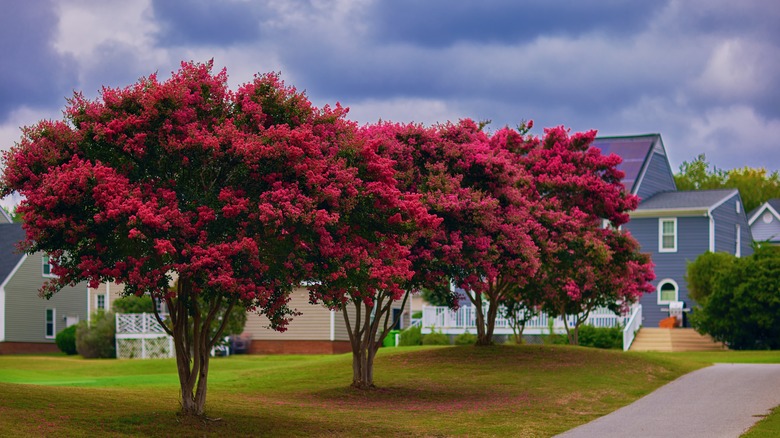Must-Know Care Tips To Ensure A Healthy And Thriving Crepe Myrtle Tree
For those who reside in USDA hardiness zones 6 through 9, the crepe myrtle tree offers the full package of beautiful showy flowers during summer, fiery fall foliage in autumn, and gorgeous multitoned bark all year long. A crepe myrtle tree that is well cared for can live on to provide your lawn with year-round beauty for decades to come. Like most flowering trees, however, the crepe myrtle is not without its fair share of challenges for gardeners and landscapers who grow it.
While a properly placed and planted crepe myrtle can be considered a low-maintenance tree, it will still require ongoing monitoring and care. In addition to basic watering and soil health, your tree will require regular fungus and mold checks and annual pruning. If you've been considering planting a crepe myrtle tree or struggling to care for one that already exists on your property, consider this your guide to proper crepe myrtle care.
Water, soil, and sunlight requirements
Before you begin to worry about how to maintain and care for your crepe myrtle tree, it's important to review its basic requirements for planting. These trees require full sun exposure and need a minimum of six hours of direct sunlight per day to thrive. Thanks to their propensity for fungal and mold growth, they also require plenty of space for maximum airflow and soil that is well-draining and neutral or slightly acidic. Adding fertilizer to the soil is not just unnecessary — it actually discourages blooming. However, mulch is recommended.
If you are attempting to care for a crepe myrtle tree that was planted by someone else and you notice that its placement is not ideal, don't be afraid to transplant it. For best results, wait until autumn when the tree is dormant but the soil is still warm or early spring before it begins new growth. Carefully dig up the tree with its root ball attached and replant it in a spot that better meets its need for direct sunlight, airflow, and drainage.
Pruning and disease detection
While crepe myrtle trees don't require frequent pruning, they should be trimmed once each year in late winter. Waiting until the second half of the winter season to prune your tree ensures that the branches will be bare, exposed, and easy to see. The easiest trimming method is to simply cut away any damaged, sickly, or dried branches. If you'd like to control the size of your tree, you can trim each branch back to the point where the bark becomes exposed. Be careful never to remove more than 25% of the tree in one year.
The process of pruning provides you with an excellent opportunity to check your crepe myrtle for fungus and mold. As you examine each branch for trimming purposes, look for clusters of white or gray powder on any part of the plant. If you spot signs of powdery mildew, remove any affected small branches, leaves, or blooms. If mildew remains on the tree, treat it with a general purpose fungicide or try a home remedy for powdery mildew.


